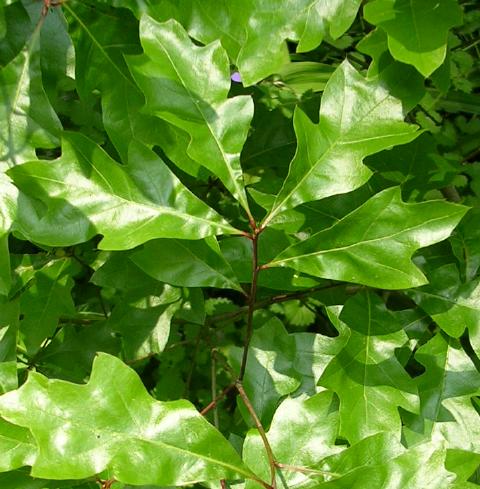- Georgia oak
Taxobox
name = Georgia oak
status = EN
status_system = iucn2.3

image_width = 240px
image_caption = Georgia oak leaves
regnum =Plant ae
divisio = Magnoliophyta
classis =Magnoliopsida
ordo =Fagales
familia =Fagaceae
genus = "Quercus"
sectio = "Lobatae"
species = "Q. georgiana"
binomial = "Quercus georgiana"
binomial_authority = M. A. CurtisThe Georgia oak ("Quercus georgiana"), also called the Stone Mountain oak, is a rare deciduous
oak . It is native to the southeasternUnited States , with a very restricted range in the southernAppalachian Mountains and outlyingmonadnock s, mainly in northern Georgia, but also very locally in portions ofAlabama andSouth Carolina . It grows on dry granite and sandstone outcrops of mountain slopes at 50-500 m altitude.It is a small
tree , oftenshrub by, growing to 8-15 m (25-50 feet) tall. The shiny green leaves are 4-13 cm (2-5 inches) long and 2-9 cm wide, with a 0.6-2.3 cm petiole, and five irregular, pointed, bristle-tipped lobes; they are glabrous (hairless), except for small but conspicuous tufts of hairs in the vein axils on the underside. The leaves turn dark red to brown in the autumn, stay on the tree throughout the winter, and fall as the new leaves bud in the spring. The acorns are round, 9-14 mm long, maturing about 18 months after pollination.The Georgia oak is classified in the red oak section "Quercus" sect. "Lobatae". The tree was first discovered in 1849 at
Stone Mountain , Georgia, where several specimens grow along the popular walk-up trail. In the wild they are often shrub-like.It is occasionally cultivated as a specimen or garden tree in
USDA plant hardiness zone s 5-8. Besides landscapehorticulture , the Georgia oak has no commercial uses.References
* Listed as Endangered (EN B1+2ce v2.3)
* [http://www.efloras.org/florataxon.aspx?flora_id=1&taxon_id=233501038 Flora of North America - "Quercus georgiana"]
Wikimedia Foundation. 2010.
